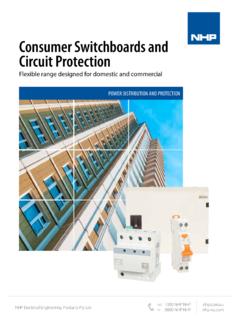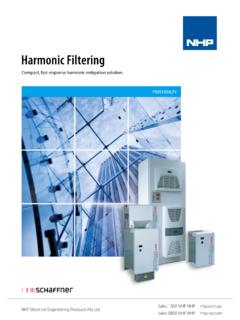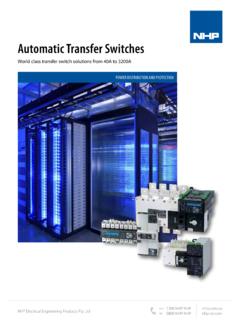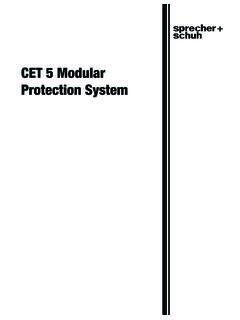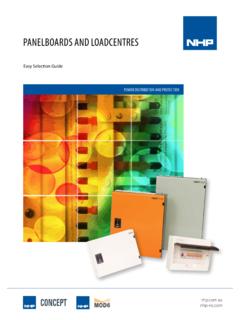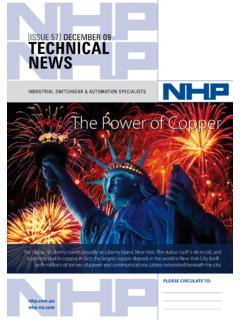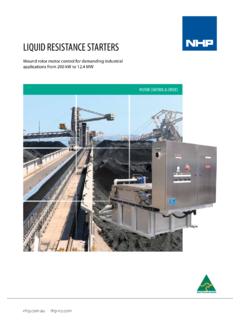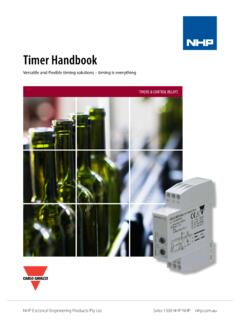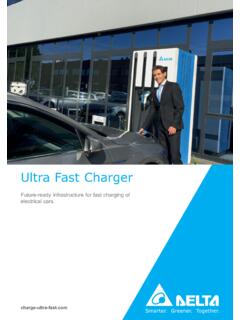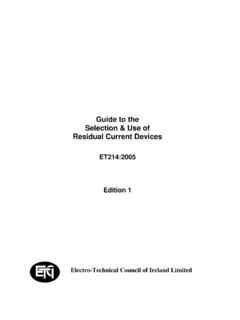Transcription of MINIATURE CIRCUIT BREAKERS & RESIDUAL …
1 MINIATURE CIRCUIT BREAKERS & RESIDUAL current Selection GuidePOWER DISTRIBUTION AND PROTECTION2 MINIATURE CIRCUIT BREAKERS (MCBs) provide short CIRCUIT and overload protection for circuits traditionally up to 125A. RESIDUAL current Devices (RCDs) are devices intended to isolate supply to protected circuits, socket-outlets or electrical equipment in the event of a current flow to earth that exceeds a predetermined value AS/NZS 3000 RESIDUAL current breaker with Over- current Protection (RCBOs) are devices that combine both the performance of a MCB and RCD for circuits traditionally up to 1: MCB, RCD or RCBO?
2 STEP 2: What is the number of poles? DIN-T MOD6 SAFE-TNHP offer two types of MCBs: current limiting type: CIRCUIT breaker with sufficiently short trip time to prevent the short- CIRCUIT current from reaching the peak value. Defined by B, C and D curves. DIN-T and MOD6 MCBs are current limiting type. Zero point: CIRCUIT breaker that interrupts a fault and isolates the energy once the AC wave form crosses the zero crossing point. Not defined by B, C and D curves.
3 Safe-T MCBs are zero point RCDs described in this quick selection guide are fixed setting RCDs complying with AS/NZS 3190, AS/NZS or AS/NZS and intended for use in fixed installations. RCDs are also referred to as RCCBs ( RESIDUAL current CIRCUIT BREAKERS ). Refer to the FAQ section for more information on RCDs. RCBOs have two functions: To provide protection against overload currents and short circuits. To provide protection against earth leakage range of 1, 2, 3 and 4 pole MCBs and RCDs are available.
4 Note: This is not referring to the width of the deviceYou need to select the appropriate number of poles to provide the necessary EXAMPLES1 PoleSingle phase power PoleConnection to active and neutral conductor OR Connection to two active conductors if device is suitably require connection to both phase and neutral as a PoleThree phase circuits with no Induction PoleThree phase circuits with three phase power 3: What is the current rating requirement?MCBs:As per the AS/NZS 3000 wiring rules, the current rating of CIRCUIT - BREAKERS (IN) should not be greater than the cable current -carrying capacity (IZ).
5 It should also be greater than or equal to the maximum current that the system is expected to carry (IB). IB IN IZ OR Maximum full-load current in the system MCB current Rating Cable RatingRCDs: The load current rating of an RCD shall NOT be less than (a) The maximum demand of the portion of the electrical installation being protected by the device; or(b) The highest current rating of any overload protective device on the portion of the electrical installation being 4: What is the voltage of the network?
6 STEP 5: What minimum breaking capacity is required?STEP 6: What MCB curve type is required?The nominal voltage for the DIN-T, MOD6 and Safe-T devices is 240 voltages may be allowed including DC voltages however please check the technical data for each item in example: Most DIN-T MCBs can operate with a voltage between 12 VAC 440 VAC. Whereas, the DIN-T RCDs require 230/400 VAC in order for the test CIRCUIT to operate dedicated DC range of DIN-T MCBs is also available (up to 880 VDC). Please note these are polarity sensitive.
7 As per AS/NZS 3000 Protective devices providing protection against both overload and short CIRCUIT current shall be capable of breaking any overcurrent up to and including the prospective short- CIRCUIT current at the point where the device is installed. The prospective short- CIRCUIT current is the maximum amount of current which can exist in a given electrical system under short- CIRCUIT Safe-T and MOD6 range are available with short CIRCUIT breaking capacity of is available with short CIRCUIT breaking capacity from 6kA to curve type describes the trip time with respect to current (expressed as a multiple of the nominal current (IN)) see figure 1 : 1) The MOD6 series is limited to C curve type MCBs.
8 2) The Safe-T range is a NEMA style (zero point) MCB with a general curve type. For more information please refer to NHP Catalogue Part C Section NHP DIN-T range offers 3 different types:B CURVE3-5x INSuitable for resistive loads such as electrical heating, water heater and stoves and long cable runs (fault loop impedance).C CURVE5-10x INSuitable for common loads such as lighting, socket outlets, small CURVE10-20x INSuitable for high inrush loads and specific6stepMCB specificFigure 1: Tripping curves according to AS/NZS 6089847step8stepSTEP 7: What RCD type?
9 STEP 8: What trip sensitivity is required? Different types of RCDs are available differentiated by their behaviour in the presence of AC and/or DC current and trip sensitivity (Rated RESIDUAL Operating current ) of the RCD is the minimum level of earth leakage current required to operate the device. The selection of the trip sensitivity needs to take into account the purpose of the RCD. 10mA RCDs may be used in areas of increased risk such as circuits supplying outdoor equipment, bathrooms, kindergartens and hospitals.
10 However, the standing leakage current from appliances may cause nuisance trip sensitivity is the minimum requirement for providing personnel protection whereas RCDs with lower trip sensitivity (ie. 100mA or above), may be selected to avoid unwanted nuisance tripping when installing the RCD for the purpose of equipment protection or protection against fire hazards due to persistent earth fault currents not tripping the overcurrent protective refer to AS/NZS 3000 for further specificRCD specificTYPEDESCRIPTIONUSEACType AC RCDs are designed to operate when RESIDUAL sinusoidal alternating currents are type of RCDs are ideal for circuits containing AC operated equipment general purpose applications.
![[CATALOGUE TB2-CAT] TEMBREAK 2 MOULDED …](/cache/preview/6/3/1/3/d/b/b/2/thumb-6313dbb2a06c3f72e0063d5e815c6636.jpg)
